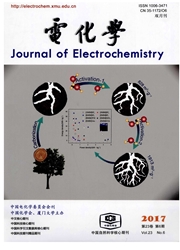

 中文摘要:
中文摘要:
应用密度泛函理论(DFT)反应能计算及最小能量路径分析研究了CO2在气相和电化学环境中于Cu(111)单晶表面的还原过程.气相CO2还原为碳氢化合物的反应路径可能为:CO2(g)+H*→COOH*→(CO+OH)*→CHO*;CHO+H*→CH2O*→(CH2+O)*;CH2*+2H*→CH4或2CH2*→C2H4.整个反应由CO2(g)+H*→COOH*→(CO+OH)*,(CO+H)*→CHO*和CH2O*→(CH2+O)*等几个步骤联合控制.在-0.50 V(vs.RHE)以正的电势下,CO2在Cu(111)表面电化学还原主要形成HCOO-和CO吸附物;随着电势逐渐负移,CO2加氢解离形成CO的反应越来越容易,CO成为主要产物;随电势进一步变负,形成碳氢化合物的趋势逐渐变强.与CO2的气相化学还原不同的是,电化学环境下CO质子化形成的CHO中间体倾向于解离形成CH,而在气相中CHO中间体则倾向于进一步质子化形成CH2O中间体.
 英文摘要:
英文摘要:
The CO2 reduction on Cu(111) single crystal surfaces was studied using DFT calculations on the reaction energies and the minimum energy paths.The results indicated that the possible reaction paths for CO2 reduction on Cu(111) surface are CO2(g)+H*→COOH*→(CO+OH)*,(CO+H)*→CHO*,CHO+H→CH2O*→(CH2+O)*,CH2*+2H*→CH4 or 2CH2*→C2H4.On Cu(111) surface,the reaction rate is controlled by steps of CH2O*→(CH2+O)*,CO2(g)+H*→COOH→(CO+OH)* and(CO+H)*→CHO*.In addition,the reaction energies for various steps in the electrochemical reduction of CO2 were calculated under different electrode potentials.The results indicated that HCOO-and CO are mainly formed when the potential is more positive than-0.50 V(vs.RHE).The hydrogenated dissociation of CO2 to form CO and the subsequent hydrogenation of CO become increasingly exothermic as the potential goes negative,so that hydrocarbons gradually become the favored products in the electrochemical reduction.Under electrochemical conditions,the CHO intermediate prefers to dissociate to form CH,rather than to form CH2O intermediate via protonation as does in gas phase reduction.
 同期刊论文项目
同期刊论文项目
 同项目期刊论文
同项目期刊论文
 The Voltammetric Responses of Nanometer-Sized Electrodes in Weakly Supported Electrolyte: A Theoreti
The Voltammetric Responses of Nanometer-Sized Electrodes in Weakly Supported Electrolyte: A Theoreti A Highly Stable Catalyst for PEM Fuel Cell Based on Durable Titanium Diboride Support and Polymer St
A Highly Stable Catalyst for PEM Fuel Cell Based on Durable Titanium Diboride Support and Polymer St A new experimental approach for the determination of exchange current density for hydrogen electrode
A new experimental approach for the determination of exchange current density for hydrogen electrode Density functional theory (DFT)-based modified embedded atom method potentials: Bridging the gap bet
Density functional theory (DFT)-based modified embedded atom method potentials: Bridging the gap bet Recycling of Key Materials for Membrane Electrode Assembly Applied in PEM Fuel Cell by Acid Processi
Recycling of Key Materials for Membrane Electrode Assembly Applied in PEM Fuel Cell by Acid Processi Accelerated Durability Tests of Catalyst Layers with Various Pore Volume for Catalyst Coated Membran
Accelerated Durability Tests of Catalyst Layers with Various Pore Volume for Catalyst Coated Membran Perfluorosulfonic acid-functionalized Pt/carbon nanotube catalysts with enhanced stability and perfo
Perfluorosulfonic acid-functionalized Pt/carbon nanotube catalysts with enhanced stability and perfo Efficient and Superiorly Durable Pt-lean Electrocatalysts of Pt-W Alloys for Oxygen Reduction Reacti
Efficient and Superiorly Durable Pt-lean Electrocatalysts of Pt-W Alloys for Oxygen Reduction Reacti Comparative Study of Oxygen Reduction Reaction Mechanisms on the Pd(111) and Pt(111) Surfaces in Aci
Comparative Study of Oxygen Reduction Reaction Mechanisms on the Pd(111) and Pt(111) Surfaces in Aci Three-dimensional ordered macroporous IrO2 as electrocatalyst for oxygen evolution reaction in acidi
Three-dimensional ordered macroporous IrO2 as electrocatalyst for oxygen evolution reaction in acidi Fe-N doped Carbon Nanotube/Graphene Composite: Facile Synthesis and Superior Electrocatalytic Activi
Fe-N doped Carbon Nanotube/Graphene Composite: Facile Synthesis and Superior Electrocatalytic Activi Enhanced-electrocatalytic activity of Pt nanoparticles supported on nitrogen-doped carbon for the ox
Enhanced-electrocatalytic activity of Pt nanoparticles supported on nitrogen-doped carbon for the ox 期刊信息
期刊信息
